Remaking the Medina
Air Date: Week of April 24, 2009
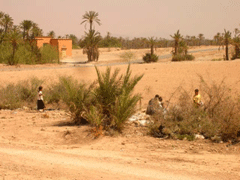
Children pick up trash in the Marrakech Palmery project. (Courtesy of Gary Martin)
The medina, the old town of Marrakech, Morocco, was once known as “the garden city of North Africa.” Private homes had verdant courtyards; orchards, grapevines and trees filled the city streets. But as the population grew, the gardens made way for shops and houses. In 2002 Clark Boyd reported on efforts to bring back the gardens of the medina. Host Jeff Young checks in with ethno-botanist Gary Martin to see if the people of Medina are living the lush life.
Transcript
YOUNG: We’ve been celebrating Earth Day for the entire month of April by checking out our archives, and checking in on developments in some memorable stories from past years.
Today we head back to 2002 – to the Moroccan city of Marrakech. Since it was founded in the year 1071, Marrakech has been an oasis at the edge of the Sahara, a place of rest and comfort for traders from across Africa and Europe. Traditionally the city's old town, known as the medina, was filled with gardens, full of vines and fruit trees. But in more recent years the population of Marrakech exploded, and houses replaced green spaces.
As Clark Boyd reported, a group of citizens banded together to re-green the medina of Marrakech.
[SOUND OF MUSIC AND VOICES]
BOYD: Walking through the Marrakech medina, it's hard to believe that this was once known as the "Garden City of North Africa." Every inch of the old part of the city looks like it's covered in concrete and asphalt, and all of it is constantly buzzing with human activity.
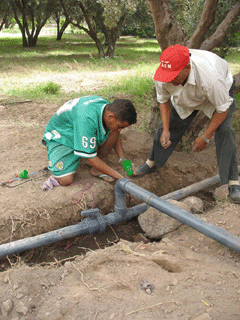
Working on the irrigation system. (Courtesy of Gary J. Martin)
[SOUND OF TRAFFIC]
BOYD: BMWs and horse carts jockey for position on the medina's narrow streets, while in the walkways through the markets, craftsmen busily prepare for the day's business.
[SOUND OF HAMMERING]
BOYD: Historically, a majority of the space inside the walls of the medina was devoted to what western city planners today would call "green space." Residents used the land to plant gardens, fruit orchards, and climbing vines. In the early 1900's, the medina supported a population of about 60,000 people. Now it's home to four times that many residents.
AL ALAWI: As you see, once we go through any of the gates, it really gets--
BOYD: Hicham Al Alawi is a tour guide and life long resident of the Marrakech medina. Alawi says that the population increase began when Moroccans started migrating to the cities a century ago.
AL ALAWI: A lot of people have immigrated from the countryside actually inside the medina because of the drought, because of the economic conditions that haven't been really at the ease of those people, and they were seeking of improving their ways of life.
BOYD: And as the population grew, the green spaces dwindled. In the inner courtyards at the medina's private homes, plants and trees were cut down to make space for shopkeepers. Vegetable gardens that once provided ample food for the people were dug under when new housing was built on the land. Even the sultan's impressive Royal Gardens, once the pride of all the medina's residents, were left to whither away to dirt as water resources were taken over by the burgeoning population. Residents like Mustafa, who makes clothing and who has been working in the medina since he was six, bemoan the loss.
[MUSTAFA SPEAKING ARABIC]
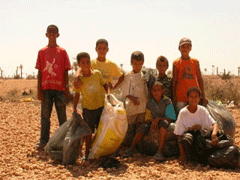
The children of Douar Abiad picked up 150 kg of plastic bags, earning 1,5 dirhams for each kilo. (Courtesy of Gary Martin)
MALE VOICEOVER: I remember when there was a huge, shadowy olive tree in the spice market. But they cut it down, because they needed the space. They didn't realize that after they cut it down, they'd have to stand in the hot sun all day.
BOYD: Marrakech natives aren't the only ones who've noticed the decline of the city's gardens. Gary Martin is an ethnobotanist who has lived in Marrakech for 15 years. He fears that the decline of the gardens is affecting the ecological balance of the Marrakech area.
MARTIN: It is the point of botanical diversity, a place of great floristic diversity in North Africa. It's the most diverse area in the Mediterranean basin if you exclude Turkey, and the biological diversity in terms of plant and animal species that you certainly find here, is clearly matched by the cultural diversity.

Children pick up trash in the Marrakech Palmery project. (Courtesy of Gary Martin)
BOYD: And so Martin decided to try to save the medina's green spaces. He started up a non-profit called the Global Diversity Foundation. With the goal of "re-greening" the Marrakech medina, Martin first turned to Mohammed El Faiz, author of two books on the gardens of Marrakech. El Faiz says that traditional Moroccan gardens weren't just pretty.
[EL FAIZ SPEAKING FRENCH]
MALE VOICEOVER: Sure these gardens were decorative, but they also helped the people by having vegetation: fruit trees, aromatic plants, medicinal plants. There was a functionality to the gardens.
BOYD: El Faiz's knowledge, along with input from residents, helped the Global Diversity Foundation's Gary Martin plan how best to bring back the medina's green spaces. The idea, says Martin, is to try to get people to use whatever space is left for greenery to refurbish the old royal gardens with plants, and to encourage homeowners to once again devote courtyard space to trees and vines.
MARTIN: Let's do re-greening with some of the historically resident species; the things that used to grow there, that grew there for centuries, things like carob trees, grape vines, olives, date palms. These are the things that we really associate with North African civilization in general, and particularly urban areas, and areas in the rural hinterland around cities. And these are the species that are really, if you could call it that, the North African suites of useful species.
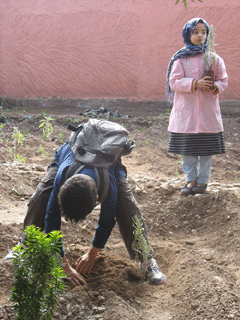
Children work in the Abi al Alaa al Miaari garden in the Marrakech medina. (Courtesy of Gary Martin)
BOYD: The municipality is working to insure that enough water flows into the medina so that all these efforts will succeed.
[SOUND OF BIRD CHIRPING, PEOPLE'S VOICES]
BOYD: In the wool market in the heart of the Marrakech medina a grape vine, or daliya, planted a year ago by the Global Diversity Foundation is now beginning to wind its way up a trellis. It's one of a number of small re-greening projects that are in the works here. The idea is to use small amounts of money to start the initial plantings, and then let the locals take over.
More than 400 women sell clothing here, and they fiercely guard and tend the vine, no one more so than 60-year-old Fatima.
[FATIMA SPEAKING ARABIC]
FEMALE VOICEOVER: I water it every evening when the temperature cools off. I also make sure the vine is fertilized, and that the weeds are removed. I tell all the other ladies here to do the same.
BOYD: Fatima and the others say that they can't wait until the summer when they'll be able to sit in the shade under the vine, sipping a cool drink.
[SNAKE CHARMER MUSIC]
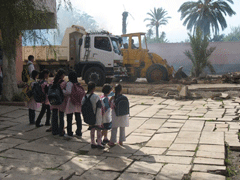
Children from Oum Salama watch construction of the garden. (Courtesy of Gary Martin)
BOYD: They also plan on divvying up the grapes that they grow amongst themselves, a throwback to the old days when the medina's green spaces were shared equally among all. For Living on Earth, this is Clark Boyd in Marrakech, Morocco.
YOUNG: We first aired that report on efforts to regreen the Medina of Marrakech back in 2002.
Global Diversity Foundation’s director, Gary Martin, has been listening in. He’s the ethnobotonist that we heard from in the story and he joins us by phone from Paris.
Mr. Martin, welcome back to the program.
MARTIN: Oh thanks. Thanks for having me back.
YOUNG: Well, how do the gardens of medina grow these days?
MARTIN: Well, actually there’s so pretty good news. One of the things that we did after that report was to focus particularly on working with school children and to do school gardens. We have created a garden, actually in 2003 at the Ibn Abi Sofra primary school. And that one’s going strong after six years. The kids are cultivating their own fruits and vegetables. They’re eating them in the school cafeteria. And that’s contributing to enriching school lunches for over 150 kids at that particular school.
YOUNG: What kind of feedback do you get from the residents who tend to or benefit from these gardens? Do you get a sense that they are invested in this, feel like stakeholders and wanna protect the gardens?
MARTIN: Yeah, definitely. I think that everybody is happy when they’re in the garden. And that’s probably even more true in a very arid zone, a zone of oases and where the only green space is our gardens. And for that reason, there’s quite a bit of popular support for this idea of bringing back to palm grove, bringing back to gardens in the city itself. And that’s, I would say, pretty much across the board, from people who are from Marrakech, who’ve grown up there or from the middle of the medina, out to the palm grove and the people who have recently moved there – of which there’s, in fact, quite a number of people from Europe and the United States that are starting to become established in Marrakech.
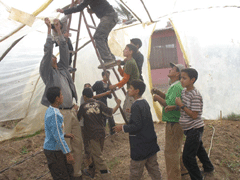
Raising the greenhouse. (Courtesy of Gary Martin)
YOUNG: What about the effort to restore the royal gardens, which I understand had just been allowed to kind of wither away?
MARTIN: Well, I have to say the royal gardens are not withering away – they’re part of the royal domain and that means its part of the royal family’s lands. And they’re being maintained. There hasn’t been a big effort to restore them and open them to the public. But on the other hand there’s something else that’s very exciting that’s going on that the royal family’s very involved in and that is bringing back the palm grove of Marrakech, what is called the palmery of Marrakech.
YOUNG: Tell me about that.
MARTIN: Well, that’s an interesting project because we talked about in the previous interview that Marrakech was founded in the eleventh century. At that time, a green belt was establish around the city, apart from the gardens and the middle of the walled city – there’s a palm grove that was created, and those were thousands and thousands of palm trees. And amongst the palm trees you had small villages, small dua’a, which were cultivating orchard gardens, fruits and vegetables that then they would take to sell in the city itself. Over time, and because of the drought that Marrakech experienced in 60s, 70s, 80s, 90s, up until the present – that palmery has started to deteriorate. But now since two years ago there’s a huge effort to bring it back, to do ecological restoration. And that’s included planting just over the last two years 217,000 date palm trees.
YOUNG: Now the city has not stopped growing. It’s still booming. How is that affecting the effort to keep some space and keep some water to allow for gardens?
MARTIN: Well, that’s a bit the down side. You’re absolutely right, there’s a massive building boom in Marrakech. It’s taking its toll on the very scarce water resources of the city. We had a little bit of a respite this year because we had the rainiest year since 1963. And when I left Marrakech this morning, it was a blooming city, the roses are in bloom, the pomegranates are in bloom, the carob fruits are on the trees. The olive trees are in flower. So it’s looking quite good this year. But the difficulty is, in fact, that with so much building going on, there’s a lot of ground water pumping and this is leading to quite a big impact on the scare water resources of Marrakech.
YOUNG: Now someone in the story mentioned the importance of shade, which I imagine is very important in that part of the world. Is there more shade now as a result of these efforts?
MARTIN: Well to some extent there is more shade. You certainly won’t find a forest if you come to Marrakech, but you will be finding additional palm trees from the palm grove, other trees growing around them, and a little bit more shade.
YOUNG: Are there benefits here as cities look to coping with climate change? And I’m guessing in a city like this, if the world’s gonna get warmer, things like this are of greater benefit, aren’t they?
MARTIN: Yes, they certainly are. This is – it’s a very interesting question because adapting to climate change, from my point of view, means reaching back into the traditions and the practices and the beliefs of the people who have bee interacting with the environment for a very long time. In this case the original inhabitants of the medina of Marrakech, of the palm groves of Marrakech – and that tradition, those traditions and beliefs and know how have been passed along in terms of how to take care of the Palm Grove, how to have an orchard garden, how to grow plants. I think these communities that are really living very closely with their environment, are the ones that are going to be leading the way in how to adapt to climate change. And, in fact, hopefully, how to mitigate climate change.
YOUNG: I thank you very much for your time. Gary Martin is an ethnobotanist with Global Diversity Foundation and he’s been giving an update on the effort to re-green the Medina of Marrakech. Mr. Martin, thanks very much.
MARTIN: Thank you.
Living on Earth wants to hear from you!
Living on Earth
62 Calef Highway, Suite 212
Lee, NH 03861
Telephone: 617-287-4121
E-mail: comments@loe.org
Newsletter [Click here]
Donate to Living on Earth!
Living on Earth is an independent media program and relies entirely on contributions from listeners and institutions supporting public service. Please donate now to preserve an independent environmental voice.
NewsletterLiving on Earth offers a weekly delivery of the show's rundown to your mailbox. Sign up for our newsletter today!
 Sailors For The Sea: Be the change you want to sea.
Sailors For The Sea: Be the change you want to sea.
 The Grantham Foundation for the Protection of the Environment: Committed to protecting and improving the health of the global environment.
The Grantham Foundation for the Protection of the Environment: Committed to protecting and improving the health of the global environment.
 Contribute to Living on Earth and receive, as our gift to you, an archival print of one of Mark Seth Lender's extraordinary wildlife photographs. Follow the link to see Mark's current collection of photographs.
Contribute to Living on Earth and receive, as our gift to you, an archival print of one of Mark Seth Lender's extraordinary wildlife photographs. Follow the link to see Mark's current collection of photographs.
 Buy a signed copy of Mark Seth Lender's book Smeagull the Seagull & support Living on Earth
Buy a signed copy of Mark Seth Lender's book Smeagull the Seagull & support Living on Earth

